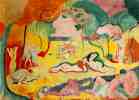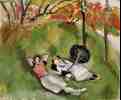![]()
Timeline: The 20th century
Instinct must be thwarted just as one prunes the branches of a tree
so that it will grow better.
-- Henri Matisse
Matisse, Henri (-Émile-Benoît)
(b. Dec. 31, 1869, Le Cateau, Picardy, Fr.--d. Nov. 3, 1954, Nice)
artist often regarded as the most important French painter of the 20th century.
The leader of the
Fauvist
movement around 1900,
Matisse pursued the expressiveness of colour throughout his career.
His subjects were largely domestic or figurative, and a distinct
Mediterranean verve presides in the treatment.
The art of our century has been dominated by two men: Henri Matisse and Pablo Picasso. They are artists of classical greatness, and their visionary forays into new art have changed our understanding of the world. Matisse was the elder of the two, but he was a slower and more methodical man by temperament and it was Picasso who initially made the greater splash. Matisse, like Raphael, was a born leader and taught and encouraged other painters, while Picasso, like Michelangelo, inhibited them with his power: he was a natural czar.
Matisse's artistic career was long and varied, covering many different styles of painting from Impressionism to near Abstraction. Early on in his career Matisse was viewed as a Fauvist, and his celebration of bright colors reached its peak in 1917 when he began to spend time on the French Riviera at Nice and Vence. Here he concentrated on reflecting the sensual color of his surroundings and completed some of his most exciting paintings. In 1941 Matisse was diagnosed as having duodenal cancer and was permanently confined to a wheelchair. It was in this condition that he completed the magnificent Chapel of the Rosary in Vence.
Matisse's art has an astonishing force and lives by innate right in a paradise world into which Matisse draws all his viewers. He gravitated to the beautiful and produced some of the most powerful beauty ever painted. He was a man of anxious temperament, just as Picasso, who saw him as his only rival, was a man of peasant fears, well concealed. Both artists, in their own fashion, dealt with these disturbances through the sublimation of painting: Picasso destroyed his fear of women in his art, while Matisse coaxed his nervous tension into serenity. He spoke of his art as being like "a good armchair"-- a ludicrously inept comparison for such a brilliant man-- but his art was a respite, a reprieve, a comfort to him.
Matisse initially became famous as the King of the
Fauves
, an
inappropriate name for this gentlemanly intellectual: there was no wildness
in him, though there was much passion. He is an awesomely controlled artist,
and his spirit, his mind, always had the upper hand over the "beast"
of Fauvism.
 Notre-Dame, une fin d'après-midi
(A Glimpse of Notre Dame in the Late Afternoon)
Notre-Dame, une fin d'après-midi
(A Glimpse of Notre Dame in the Late Afternoon)
1902 (130 Kb);
Oil on paper mounted on canvas, 72.5 x 54.5 cm (28 1/2 x 21 1/2 in);
Albright-Knox Art Gallery, Buffalo, NY
 Le bonheur de vivre (The Joy of Life)
Le bonheur de vivre (The Joy of Life)
1905-06 (150 Kb); Oil on canvas, 175 x 241 cm (69 1/8 x 94 7/8 in);
Barnes Foundation, Merion, PA
 Flowers in a Pitcher
Flowers in a Pitcher
1906 (100 Kb); Canvas, 21 1/2 x 18 in;
Barnes Foundation
Photograph by Charalambos Amvrosiou
 Mme Matisse: Madras Rouge (The Red Madras Headress)
Mme Matisse: Madras Rouge (The Red Madras Headress)
Summer 1907 (120 Kb); Oil on canvas, 99.4 x 80.5 cm (39 1/8 x 31 3/4 in);
Barnes Foundation, Merion, PA
 Le Rifain assis (Seated Riffian)
Le Rifain assis (Seated Riffian)
Late 1912 or early 1913 (130 Kb);
Oil on canvas, 200 x 160 cm (78 3/4 x 63 in),
Barnes Foundation, Merion, PA
 La leçon de musique (The Music Lesson)
La leçon de musique (The Music Lesson)
1917 (160 Kb); Oil on canvas, 244.7 x 200.7 cm (96 3/8 x 79 in);
Barnes Foundation, Merion, PA
 Seated Figure, Tan Room
Seated Figure, Tan Room
1918 (110 Kb); 16 x 13 in;
Barnes Foundation
Photograph by Charalambos Amvrosiou
 Two Figures Reclining in a Landscape
Two Figures Reclining in a Landscape
1921 (150 Kb); 15 x 18 3/8 in;
Barnes Foundation
Photograph by Charalambos Amvrosiou
 Robe violette et Anemones
Robe violette et Anemones
1937;
Purple Robe and Anemones;
Cone Collection, Baltimore Museum of Art
 La Musique
La Musique
1939 (180 Kb); Oil on canvas, 115.2 x 115.2 cm (45 3/8 x 45 3/8 in);
Albright-Knox Art Gallery, Buffalo, NY
 Deux fillettes, fond jaune et rouge (Two Girls in a Yellow and Red Interior)
Deux fillettes, fond jaune et rouge (Two Girls in a Yellow and Red Interior)
1947 (160 Kb); Oil on canvas, 61 x 49.8 cm (24 x 19 3/8 in);
Barnes Foundation, Merion, PA
Matisse's Fauvist years were superseded by an experimental period, as he abandoned three-dimensional effects in favor of dramatically simplified areas of pure color, flat shape, and strong pattern. The intellectual splendor of this dazzlingly beautiful art appealed to the Russian mentality, and many great Matisses are now in Russia. One is The Conversation (1909; 177 x 217 cm (5 ft 9 3/4 in x 7 ft 1 1/2 in)) in which husband and wife converse. But the conversation is voiceless. They are implacably opposed: the man-- a self portrait-- is dominating and upright, while the woman leans back sulkily in her chair. She is imprisoned in it, shut in on all sides. The chair's arms hem her in, and yet the chair itself is almost indistinguishable from the background: she is stuck in the prison of her whole context. The open window offers escape; she is held back by an iron railing. He towers above, as dynamic as she is passive, every line of his striped pyjamas undeviatingly upright, a wholly directed man. His neck thickens to keep his outline straight and firm, an arrow of concentrated energy. The picture cannot contain him and his head continues beyond it and into the outside world. He is greater that it all, and the sole "word" of this inimical conversation is written in the scroll of the rail: Non. Does he say no to his intensity of life? They deny each other forever.
But denial is essentially antipathetic to Matisse. He was a great celebrator, and to many his most characteristic pictures are the wonderful odalisques he painted in Nice (he loved Nice for the sheer quality of its warm, southern light). Though such a theme was not appreciated at the time, it is impossible for us to look at Odalisque with Raised Arms (1923; 65 x 50 cm (25 1/2 x 19 3/4)) and feel that Matisse is exploiting her. The woman herself is unaware of him, lost in private reverie as she surrenders to the sunlight, and she, together with the splendid opulence of her chair, he diaphanous skirt, and the intricately decorated panels on either side, all unite in a majestic whole that celebrates the glory of creation. It is not her abstract beauty that attracts Matisse, but her concrete reality. He reveals a world of supreme decoration: for example, the small black patches of underarm hair on the odalisque are almost a witty inverted comma mark round the globes of her breasts and the rose pink center of each nipple.
Picasso and Matisse were active to the end of their lives, but while Picasso was preoccupied with his ageing sexuality, Matisse moved into a period of selfless invention. In this last phase, too weak to stand at an easel, he created his papercuts, carving in colored paper, scissoring out shapes, and collaging them into sometimes vast pictures. These works, daringly brilliant, are the nearest he ever came to abstraction. Beasts of the Sea (1950; 295.5 x 154 cm (9 ft 8 in x 5 ft 1/2 in)) gives a wonderful underwater feeling of fish, sea cucumbers, sea horses, and water-weeds, the liquid liberty of the submarine world where most of us can never go. Its geometric rightness and chromatic radiance sum up the two great gifts of this artist and it is easy to see why he is the greatest colorist of the 20th century. He understood how elements worked together, how colors and shapes could come to life most startingly when set in context: everything of Matisse's works together superbly.